The holidays are upon us, and that can mean many furrowed brows trying to figure out what token gift they can give out this year as stocking-stuffers. Something that’s a bit more interesting than a coupon book or a lotto scratcher, but also affordable enough that you can buy a few of them without having to take part in that other great holiday tradition: unnecessary credit debit.
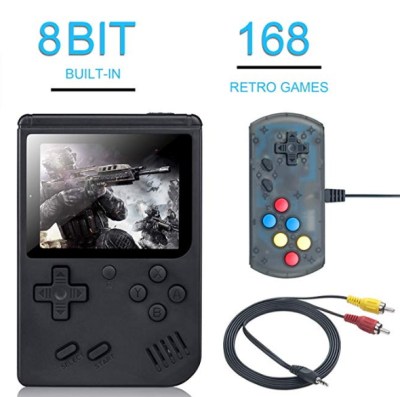
Which is how I came to possess, at least temporarily, one of these cheap handheld multi-games that are all over Amazon and eBay. The one I ordered carries the brand name Weikin, but there are dozens of identical systems available, all being sold at around the same $20 USD price point. With the outward appearance of a squat Game Boy, these systems promise to provide precisely 168 games for your mobile enjoyment, and many even include a composite video out cable and external controller for the less ambulatory classic game aficionado.
At a glance, the average Hackaday reader will probably see right through this ploy. Invariably, these devices will be using some “NES on a Chip” solution to emulate a handful of legitimate classics mixed in with enough lazy ROM hacked versions of games you almost remember to hit that oddly specific number of 168 titles. It’s nearly a foregone conclusion that at the heart of this little bundle of faux-retro gaming lies a black epoxy blob, the bane of hardware tinkerers everywhere.
Of course, there’s only one way to find out. Let’s crack open one of these budget handhelds to see what cost reduction secrets are inside. Have the designers secured their place on the Nice List? Or have we been sold the proverbial lump of coal?
A Brief Intermission
In general, I try not to present these teardowns as product reviews. It’s partially an ideological choice, but more practically, most of the gadgets I take apart simply don’t live long enough for me to actually use them as intended. But as getting permission from my significant other to take this system apart was contingent on me being able to restore it to like-new condition in time for wrapping, I’m able to give a slightly more informed than usual opinion on its operation.
The short answer is, it’s not actually that bad. The screen is bright, the buttons aren’t terrible, and on the whole it feels pretty solid. I’d go so far as to say that, given the price, I was impressed with the build quality from a user standpoint. I have no doubt that the hardware is more than worth the asking price.

As for the software, well that’s something of a mixed bag. As expected, there are a handful of games you might actually want to play included, such as all three Super Mario Bros. titles and favorites such as Contra, Adventure Island, and Spy Hunter. They’ve also wisely included NES games based on franchises that remain popular today, such as the surprisingly solid Captain America and The Avengers, and the technically impressive Batman: The Video Game.
But outside of that, the majority of the games on the system are modified into fever-dream versions of the originals, many with modern characters and themes shoehorned in.
Particular standouts include a reskinned version of Super Mario Bros. where you play as characters from Kung Fu Panda, and a bizarre side-scrolling Harry Potter shooter where you do battle against unrecognizable gremlins and what appear to be reanimated slices of bacon.
Minimal to the Extreme
Once you’ve had enough of Mr. Potters aerial escapades, the only thing standing between you and the inside of the system are a few screws on the back of the unit. Thankfully there’s no glue or clips keeping it shut, there aren’t even any wires running to the back side of the case that you need to deal with.
The first thing to note here is of course the fact that the back of the PCB is completely blank. The smooth panel is broken only by the volume knob and a connector for the battery, which is incidentally a clone of the Nokia BL-5C, perhaps one of the most bootlegged batteries of all time. Which I suppose is good news if your marathon Super Mario Bros. 14 session demands you have a second charged battery at the ready.
Flipping the system over, we can see just how little is actually on the board. Front and center is the dreaded epoxy blob, along with a 128 Mbit S29GL128P90 NOR flash chip that obviously holds the games. The datasheet for this chip (or at least, the original it’s a clone of) are readily available, so it should be possible to read its contents and potentially replace the ROMs included on the system. On the other hand, if you’re looking to play arbitrary NES ROMs on the go, there’s certainly better and more expedient ways to do it.
It’s also worth mentioning that, just like we saw with the Quirky Egg Minder, the single sided SMD board necessitates the use of zero value resistors when the traces start getting dense. However in this case we see only a handful used; a reminder that one needs to really commit if they hope to over-engineer at the same level as the fine folks at Quirky.
The Non-Controller
This system is one of the ones that comes bundled with an external controller, and while I can’t quite fathom a scenario in which it might be useful, I’ll admit that the input device was intriguing. It’s a bit small, but I liked the buttons and it felt reasonably solid in the hand. But what really had me interested was the fact it connected to the system’s USB port. Could it actually be a USB HID device?
But another black blob and the wiring would seem to suggest otherwise. The trio of communication wires made me think it was using some form of SPI, but when I connected the logic analyzer to confirm this, I found all the lines dead. Indeed, the system doesn’t seem to acknowledge the presence of the controller at all, and nothing in the manual explains if there is something I have to do to actually enable it other than plugging it in. Certainly something to keep in mind if you were excited about this particular feature.
You Get What You Pay For
Beyond the fact that the controller appears to be DOA, I’d say the system ultimately lives up to its advertising. While there’s probably no more than a dozen or so “real” NES games on the system, even the ROM hacks and bootleg titles are entertaining in their own way. If for nothing else but to see the lengths that the creators went to in an attempt to convince the user that these 30+ year old games were related to modern characters and franchises. I’d be lying if I said I wasn’t impressed with the NES-ified version of Plants vs Zombies.
From a hacking standpoint though, I’m less optimistic. When I did my teardown on The Oregon Trail handheld, I thought that it had the potential to make an excellent retro-themed Raspberry Pi handheld. With this system there’s enough room inside that you could fit a Pi Zero, but honestly there’s already Game Boy styled enclosures for the Pi that do it better so there seems little point.
Fiddling with the data on the flash and trying to insert your own ROMs would be an interesting experiment, and if anyone out there wants to take on the challenge we’d certainly love to hear about it. But personally, I think this gadget is best left as-is: a $20 stocking stuffer that will probably be forgotten come New Years.

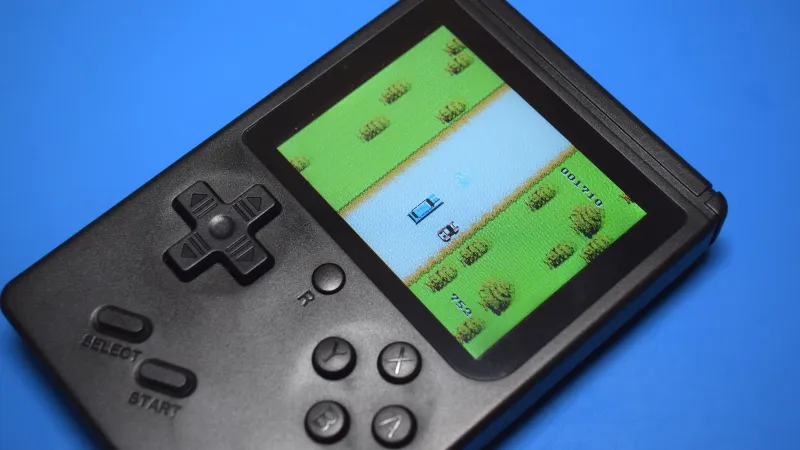
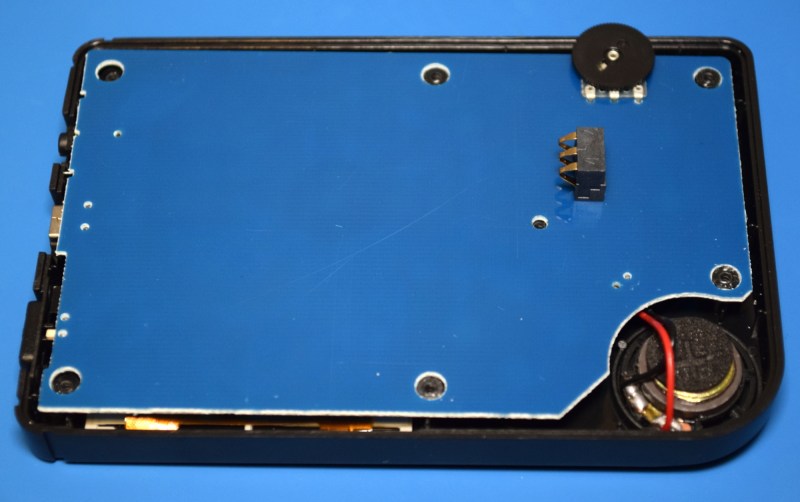
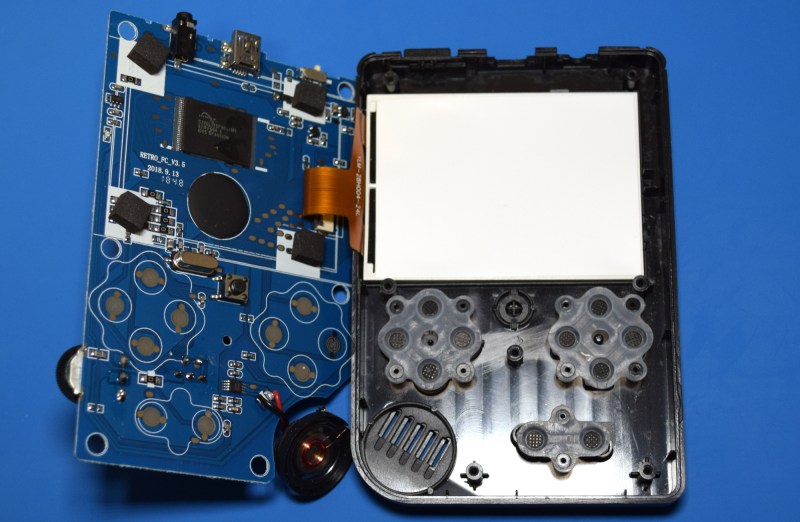
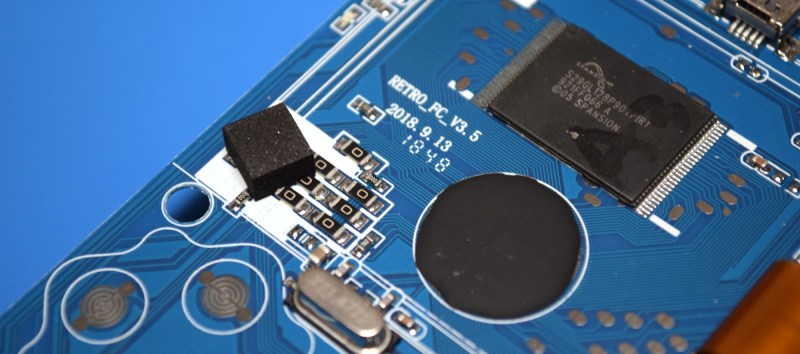















Wouldn’t be surprised if the original Gameboy molds aren’t floating around out there.
you can buy cases right of off alixpress
What’s under the epoxy blob?
There is a NOAC (Nintendo on a Chip) under the epoxy blob.
Yeah, this tear down hardly produced any goods :(
The ARM system on a chip (SoC).
Adrian Black did a review and teardown of a similar console some weeks ago, plus a fix for the video out signal.
https://youtu.be/XrieCn9-9GU
https://youtu.be/ceI4CeIN1SQ
Cool tear down – it looks like the D+/D- lines are present on the USB port? Might be interesting to see what interfaces are presented when it’s plugged in!
One of the most interesting things in electronics is how parts count seems to have nothing to do with anything.
You see things with almost no parts doing everything in software, that cost the same and work just as well as things with jam packed 0201s.
And sometimes you see devices with dozens I’ve mechanical things to line up perfectly, and on the other hand stuff you can take apart with three screws, and no noticeable difference in durability.
The only correlation I suspect is US company stuff seems a little more mechanical and harder to repair. Other than that it seems like so many products are the result of engineers looking for an excuse to apply their skills, without actually being allowed to add any cool features.
But it’s always great to see a product that enables everything the hardware is capable of.
It’s also possible these days to have a lot of hardware integrated into a single chip that used to be dozens of chips. There’s also a lot of interesting emulation-based gaming devices. I follow a channel on Youtube called “taki udon” that seems to review every single new emulation device coming out of China and there’s even sub-$100 Android devices now that have serious power.
you can get this game box only $3,5 in indonesia with additional controller (dual player pack) or $3 for single player pack.. cheaper the cigarette lol.
I wouldn’t be surprised to see that the controller uses the same control scheme as the original classic NES controller. Just a 8-Stage Static Shift Register (4021) – that’s all that it needs.
NES controller needed 5 lines: 5v, ground, clock, latch, and data. Unless the USB plug got creative and used the shell for ground and all 4 pins for the rest, it is not a NES controller clone.
There could be ways to combine the latch line with clock or 5v.
Given the silkscreen labels on the controller PCB, I strongly suspect that the controller part is a classic pseudo-SPI NES controller. The other side looks like it’s USB mini-B, which does have 5 pins.
The controller DOES work. PS=Pin Sample(latch) I’ve build a USB Controller with this and a CH552.
USB mini and micro have 5 pins
No one noticed that there are 12 buttons on the case, but only 10 on the controller’s PCB?
Yes, and they don’t work, along with the rest of the controller!
B^)
I have one of these clones. The extra controller works with the 2 player roms such as tetris.
for like $15 more you can get a Bitt-Boy PocketGO with 8gb sd that will run basically all nes/snes/gb/gbc/gba/etc games you can throw at it… plus it’s upgrade-able and mod-able
or just $5 more or the full size new bitt-boy + 8gb sd
Wonder if the controller is only for the second player in two player games? Then… no signals, normally…
> You see things with almost no parts doing everything in software, that cost the same and work just as well as things with jam packed 0201s.
I know, because the software developers work for free, right? Especially the smart ones that know how to do *everything* in software.
Addinf Rom´s to a NES Clone
https://fanlashtic.us/nes-mini-klon-part-iii/
Would be great to access the file system to update the roms over usb. Though perhaps it’s not even connected up that way? https://forums.nesdev.com/viewtopic.php?f=9&t=18652
Too bad it does not use a SPI flash chip. Much easier to dump and reprogram. I recently bought a cheap mini arcade machine that uses a VT369 NOAC (nintendo-on-a-chip) and reprogrammed it :)
https://www.youtube.com/watch?v=xljEvXlc6n4
is there a way to replace the roms?
Controller wire is the same with most Famiclone controller (Vcc Gnd Latch Clock Data). Can anyone use it as monitor?
Hi, do you how it’s connected on the micro USB? I want to do at my self, because i hace one of this famicom fake consoles controller.
Hi, can anyone give me the pinout of the controller on the micro USB, i want to do my own controller because i don’t want to spend money on a controller, i own a fake famicom controller and it has the same pinout, but i don’t know the pinout on the micro USB and i need someone to tells me how it’s, thanks, i really apreciate
Hacking in and loading up some arduboy titles would’ve been great.
I know this post is almost 1-year old, but I just found that according to this Russian forum (https://www.emu-land.net/forum/index.php/topic,81649.msg1390521.html#msg1390521), this console is based on the VT02 chip from VRT Technology (links to datasheet and AN there!)